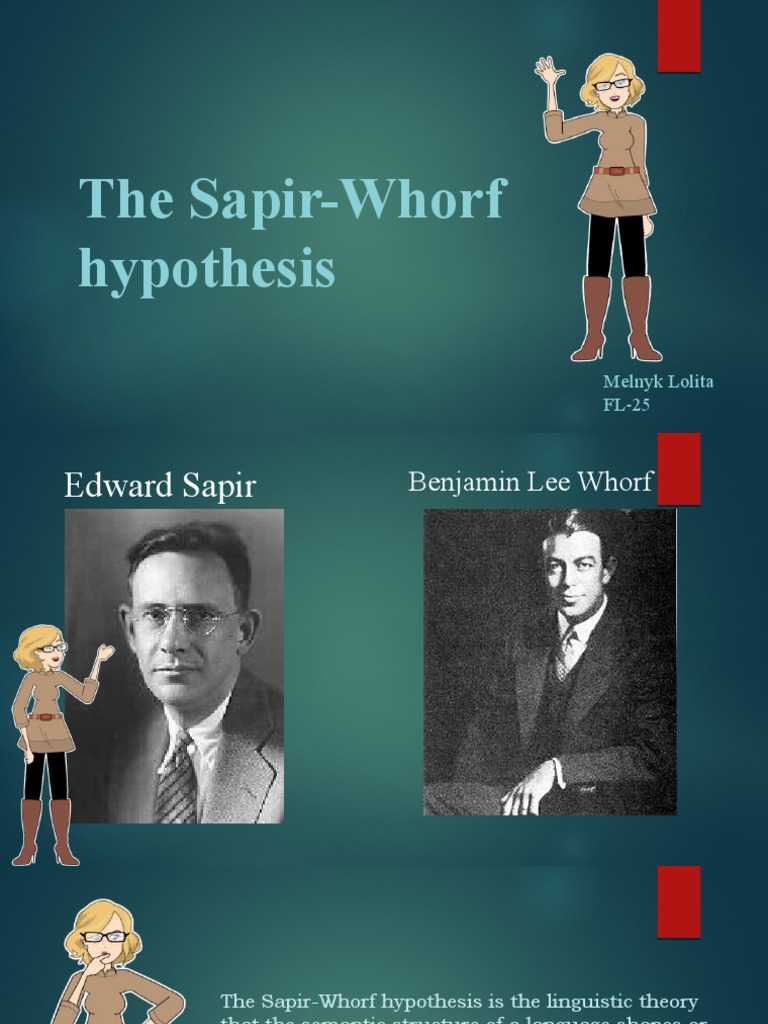The Sapir-Whorf Hypothesis, also known as linguistic relativity, posits that the structure and vocabulary of a language influence its speakers’ cognition and worldview. While the hypothesis has predominantly occupied the realms of linguistics and anthropology, its implications resonate beyond these academic disciplines, touching various aspects of culture, communication, and identity. Though fascinating in its own right, the intersection of this hypothesis with popular culture—specifically through cartoons—provides a unique lens through which we can explore the complexities of linguistic relativity.
One must first understand the dual essence of the Sapir-Whorf Hypothesis. On one hand, it suggests that language shapes thought; on the other, it implies that linguistic differences can lead to differing worldviews. These concepts have generated a myriad of interpretations over the years, spurring both proponents and detractors to engage in vigorous debate. In essence, those who advocate for the hypothesis argue that language is more than a mere tool for communication; it is that which molds our perception of reality.
When cartoons embody this concept, they offer a playful yet profound medium for critical examination. The visual dynamics of animation can elucidate abstract ideas like linguistic theory in ways that rigid academic formats may not. One remarkable observation regarding these animated portrayals is their ability to distill complex thoughts into simplistic, often humorous scenarios. This occurs through the exaggerated dramatization of dialogues or by portraying characters who exist within languages that differ significantly from one another.
In many cartoons, the artist employs characters from diverse linguistic backgrounds, often highlighting their misunderstandings, misinterpretations, or comical interactions sparked by their differing languages. This portrayal serves as a microcosm of the Sapir-Whorf Hypothesis. It emphasizes the reality that language is not merely a medium of exchange; it is an intricate system that defines and constrains our perceptions and interpretations. For instance, a cartoon might show a character whose expression of a certain emotion is bizarrely at odds with how another character interprets it, eliciting both humor and reflection.
Moreover, these artistic interpretations often hinge on common observations: the realities faced by multilingual individuals. In a globalized world where cross-cultural interactions have become commonplace, the cartoonist’s ability to tap into these experiences is both relatable and illuminating. The audience is prompted to consider how language shapes interpersonal dynamics. Do characters from varying linguistic backgrounds perceive situations differently? Do they possess distinct emotional vocabularies, and how does this affect their relationships? Such inquiries point to the deeper, almost philosophical implications of the Sapir-Whorf Hypothesis.
In addition, cartoons frequently capitalize on the absurdities inherent in linguistic structures. For example, a character might engage in an elaborate pun or wordplay that only makes sense within a specific linguistic context. Such scenarios unveil the idiosyncrasies of language while inviting viewers to examine how these peculiarities can lead to misunderstandings. By drawing attention to these nuances, animators not only generate laughs but also provoke contemplation on a broader scale—the nature of our own communication.
This is particularly salient in the age of globalization, where interaction among individuals of various linguistic backgrounds has become commonplace. The rise of the internet and social media platforms has facilitated dialogue across diverse linguistic groups. Cartoons that depict characters grappling with misunderstandings and cultural interactions offer subtle critiques on the potential pitfalls of cross-cultural communication. They encapsulate the essence of the Sapir-Whorf Hypothesis, suggesting that language shapes not only individual cognition but also communal understanding and connection.
As observable in various animated series, the implications of the Sapir-Whorf Hypothesis extend into the realm of identity formation. Language is intricately tied to culture, and one’s linguistic heritage can profoundly influence their sense of self and community. Characters in cartoons that embody this concept often reflect their linguistic and cultural backgrounds through their mannerisms, beliefs, and values. Such representations can foster a greater appreciation for linguistic diversity, urging audiences to recognize that language is a vessel for cultural identity.
This intertwining of language, relativity, and cultural identity also sheds light on the underlying function of humor in cartoons. The comedic portrayal of miscommunication or linguistic clashes serves not only as entertainment but also as a means of socio-cultural commentary. It reflects real-world challenges, offering audiences a safe space to engage with often fraught themes like discrimination, misunderstanding, and the complexity of human interactions.
Furthermore, one cannot overlook the didactic potential of cartoons rooted in the Sapir-Whorf Hypothesis. Animated narratives can serve as catalysts for discussions about language and thought, inviting audiences to reflect on their own linguistic biases. They challenge individuals to recognize that their perception of reality is but one of many, shaped deeply by their linguistic framework. This realization can engender empathy and adaptability, perhaps even advancing more thoughtful dialogs among individuals from varied backgrounds.
In summation, cartoons centered upon the Sapir-Whorf Hypothesis illustrate the profound link between language, thought, and culture. They serve as mirrors reflecting our relationships with language while unearthing complex ideas with humor and creativity. This convergence between the frivolous and the philosophical compels us to consider the critical implications of linguistic relativity on our understanding of communication and identity, provoking curiosity about how language shapes our world—and the myriad ways we interact within it.
